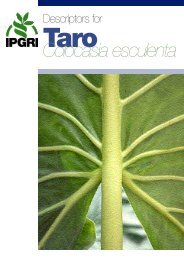Download PDF (6215 kb) - Bioversity International
Download PDF (6215 kb) - Bioversity International
Download PDF (6215 kb) - Bioversity International
Create successful ePaper yourself
Turn your PDF publications into a flip-book with our unique Google optimized e-Paper software.
EUROPEAN CENTRAL FORAGES DATABASES 23<br />
Germany - A knowledge base for disease resistance of selected cultivated plant species<br />
A knowledge base reviewing the current knowledge on disease resistance of plant species<br />
investigated in the genebank branch station North (Malchow) of IPK-Gatersleben was set up.<br />
More than 350 publications on disease resistance of the last 25 years were considered,<br />
concerning 116 host-pathogen combinations of Brassica napus L. var. oleifera, Dactylis<br />
glomerata L., Festuca arundinacea Schreb., F. pratensis Huds., F. rubra L., Lolium perenne L.,<br />
Medicago sativa L., Phleum pratense L., Poa pratensis L., Trifolium pratense L. and T. repens L.<br />
Sixteen priorities are taken into consideration such as resistant genotypes, methods of<br />
checking resistance, genetics of resistance and breeding for resistance. The knowledge base<br />
can be made topical and complete continuously and can be searched and used throughout<br />
the IPK genebank branch station Malchow. Seed samples can be requested from the<br />
genebank in Malchow. In the near future this information will be recorded on the Internet<br />
with the support of ZADI/IGR, Bonn.<br />
Greece - Breeding for drought resistance, persistence and forage productivity<br />
• Breeding of Medicago sativa L. (alfalfa) was in the first priorities of the research conducted<br />
during the last 15 years. Samples collected in different regions were evaluated in the field<br />
and great variability was found. The best plants were selected to create new populations,<br />
clones and synthetic varieties. Traditional alfalfa varieties and modern bred varieties,<br />
indigenous or introduced, were screened and the best were tested in contrasting<br />
environments under or without irrigation. The semidormant Greek varieties Dolichi,<br />
Hyliki, Hypati and Florina proved to be the most persistent and the most productive<br />
varieties under or without irrigation. Cheronia, a nondormant Greek variety, was also a<br />
good producer, but only under irrigation.<br />
• Medicago arborea L. is a drought-resistant shrub, suitable for marginal rocky soil<br />
reclamation in Mediterranean dry-hot conditions. The collection of indigenous<br />
germplasm was completed, including a total of 38 accessions. A mass selection variety<br />
named Naxos has been registered on the national list of varieties and a large number of<br />
clones and lines have been produced by selection for drought and cold resistance,<br />
leafiness and forage production.<br />
• Dactylis glomerata L., Festuca arundinacea Schreb., Lolium perenne L. (cocksfoot, tall fescue<br />
and perennial ryegrass): wild and bred populations were given a preliminary evaluation<br />
under irrigation or rain-fed conditions in individual plants or in dense sowing for heading<br />
time, drought resistance, persistence and forage production. Large variability was found<br />
for all characteristics within and between populations and was used in further breeding<br />
work of the wild indigenous germplasm, aimed at creating more productive and more<br />
persistent varieties, better adapted to dry-hot conditions. The productivity of Greek<br />
varieties, tested in Central Greece, was similar to that of foreign varieties under irrigation,<br />
while it was much higher under rain-fed conditions. Metsovo tall fescue and Olympion<br />
ryegrass are both suitable for use all over Greece under irrigation or under rain-fed<br />
conditions in cool regions. Perrevia cocksfoot could be grown well under rain-fed<br />
conditions even in the dry-hot southeastern Greece.<br />
Italy - RAPD fingerprints as a tool for characterizing the genetic background of<br />
Medicago sativa L. germplasm<br />
Lucerne is the most important forage legume crop in Italy. This study was conducted to<br />
assess the suitability of RAPD markers in detecting the genetic variability among and within<br />
lucerne landraces from central Italy. In a first experiment genetic variability estimations<br />
based on bulked plant DNA samples were assessed in 16 landraces from the Marche region;<br />
in a second experiment genetic variability estimations based on single-plant DNA samples<br />
were assessed in six landraces from the Tuscany, Umbria, Abruzzi and Lazio regions. Most<br />
landraces from Marche were found to share a common genetic background and to have a<br />
limited genetic variation within population, whereas landraces from the other regions




